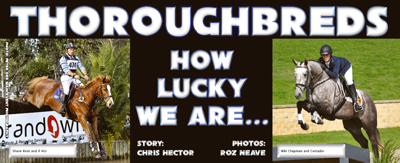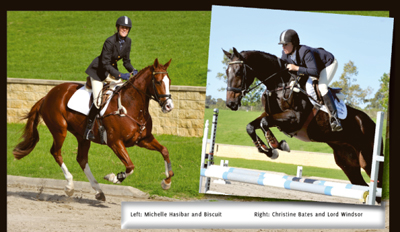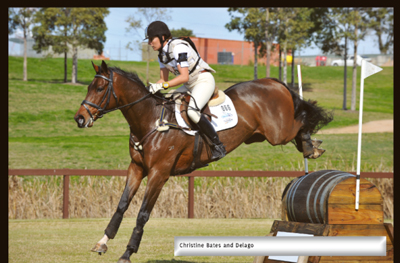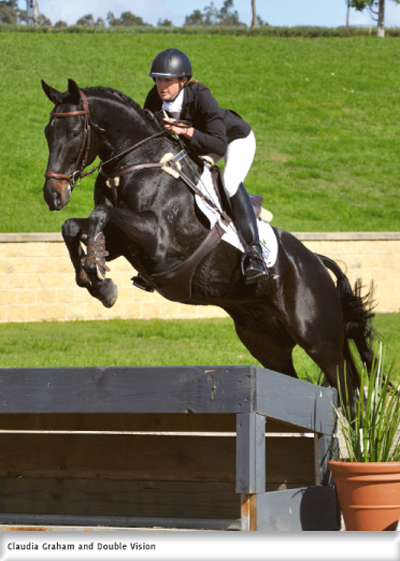As I sat and watched the Young Eventing Horse classes at this year’s Weekend of World Cups at the Sydney International Equestrian Centre, it struck me yet again how lucky we are in Australia to have such a large and vibrant Thoroughbred industry. Not only does the racing game provide much needed economic support for our riders through track work, breaking and pre-training, it also provides the economic base for our better farriers and top vets (‘without the racehorses, I wouldn’t be able to invest in the equipment I then use to help our performance horses’, one of our leading equine vets told me) but it also continues to supply wonderful horses for our eventers to ride.
Over the years, the Thoroughbred, thanks to our racing industry, has provided the overwhelming majority of our top eventing horses, including our Olympic gold medalists. Despite speculation of a Warmblood take-over that followed the modification of the three day event, eventing all around the world continues to be dominated by the ‘blood horse’, and looking at the winners in the Young Eventing Horse Classes at Weekend of World Cups at the Sydney International Equestrian Centre in May 2010, that is not about to change.
Once again, I am struck by the fact that Australian racing is so quick to ‘sack’ healthy, sound young Thoroughbreds before they have even had a race. Take for example the glorious winner of the Four Year old class, Contador with Niki Chapman. His sire, Rock of Gibraltar won over a million in prizemoney and when Contador was conceived his stud fee was a cool $120,000. So what happens? The beautiful grey gelding has four trials, not even a race, and after he has run last three times and second last once, he is out of a job. Or into a new one…
Niki and her husband, Shane Rose, are in a unique position to tap the goodies of the racing scene, they run a large, and hugely successful, Thoroughbred racehorse breaking and pre-training operation.
“We usually have about 30 or so breakers on the go, and about ten to fifteen pre-trainers, sometimes it is more, sometimes less, so I guess we are breaking about 120 Thoroughbreds a year,” says Shane.
Which means that every now and then you luck on something as cute as Contador for just $1500! As Shane explains, the grey gelding didn’t look so wonderful at first so that kept the price down…
“One of the trainers we do a bit of breaking and re-training for, said he had a horse that needed to find a new home. We had a play around with him. Niki thought he would be nice for her to ride. He’s a nice type, but he was a bit wooden in the mouth when we got him off the track. He was a bit of a klutz when he first started jumping, so we didn’t offer them too much money in case there wasn’t a lot of improvement in him – but Niki’s done a great job, he’s very nice in the mouth now, and he is jumping very well.”
Shane has also been having fun with the winner of last year’s Five Year old young event horse class, Il Vici (by Galileo out of a Salieri mare). Then the gelding attracted a rave review from the judge, 1994 World Eventing Champion, Vaughn Jefferis:
“He is one of the most quality horses I have seen in a long time. Just an athlete, gorgeous conformation, three beautiful paces, jumped with a ton of athletic ability.”
One of Shane and Niki’s best customers has been Sydney mega-star racehorse trainer, Gai Waterhouse, and it was Ms Waterhouse who sent the very expensive yearling to Shane for pre-training. After a couple of preparations, Il Vici was returned to Shane to see is he might make a performance horse…
“He has won his last two one star starts. He was fourth in his first two star class, and two of the horses that beat him in that class, one had won a four star and another had completed a four star. He is certainly developing into a lovely, lovely horse.”
He was very expensively bred, how did you get him?
“We pre-trained him two or three times for Gai Waterhouse and he has always been like he was the first time I rode him – beautiful balanced canter, uphill, and he seemed to have a lovely temperament. I followed him through his racing career, and kept telling the girls in Gai’s office, that if he ever doesn’t run fast enough, keep me in mind. And I was fortunate that they did, he wasn’t overly impressive on the track, so I sort of stole him.”
When you get them back after they have race, what problems do you encounter?
“With Il Vici, he was a bit gobbie at first, he’d lock on to one rein occasionally when he didn’t want to do something, and sort of take off. That was really the only hang up he had, and it wasn’t much of a hang up. He just has such a lovely attitude that I don’t think anything really bothers him.”
Could Il Vici go on and make an Olympic horse?
“There’s nothing to stop him going right to the top…”
You break and pre-train hundreds of Thoroughbreds, what percentage of them do you think would make successful eventers?
“If you got them as yearlings, probably about half.”
Really – I thought you were getting more and more little American style sprinter types…
“There are a lot of short ones, but there are a lot of good ones. If you look at the Thoroughbreds across the board, and you had them right from the start as performance horses, I think there would be a large percentage that would make good horses. The problem is that a lot of those horses end up being reasonable on the racetrack, and gallop too long and don’t trot enough, and then by the time we get them, they have lost their trot, as opposed to never having one, and they are more difficult in the mouth, more difficult in the mind.”
“Sure the type of Thoroughbred that we get now is often not as scopey in their frame and movement, because of the sprint factor, but there is still a large percentage that would make it as performance horses, if that was what they were aimed at – but we unfortunately don’t get to try many of them as competition horses. Of the ones I like as young horses, probably only one or two percent come back to the tried as performance horses.”
However, Shane is not prepared to rely on slow racehorses for his prospects, he is now standing at Thoroughbred stallion, Another Warrior. The 13 year old stallion was a respectable racehorse, competing (and winning) in black type races from 1400 to 3200 metres. He won eight times for $690,000 in winnings and perhaps equally importantly for the eventing scene, he was obviously a very sound horse,d with 50 starts.
Finding the stallion had something to do with Shane and Niki’s wedding earlier this year: “Karen Sheedy, who was one of Niki’s brides’ maids, has ridden a lot of horses, and owned some good ones. She and her ex-husband, bought Another Warrior as a Thoroughbred stallion. We had a couple of mares and we thought we’d put him over them to see if they would run fast. They didn’t. But we also had the thought that because he had staying blood, it wasn’t a bad line to use to breed eventers, and when they didn’t show much ability early on, we decided not to spend any more trying to make them racehorses, and started to train them for eventing, and both of the first two we bred showed real aptitude for jumping, and they are both very nice types.”
“We broke Shanghai Joe in first and we started doing a bit of eventing with him, then we brought the other one, Biscuit, back into work and he also showed eventing talent. Biscuit is out of quite a tricky mare, a lot of her progeny had a good jump but a few of them had been quite tricky on the flat. He certainly has a great attitude so it seems a lot of that is from the stallion. Shanghai Joe is out of an Arena (by Danehill) mare, and although she has never jumped, the Arenas have a reputation as jumpers. With him we weren’t sure how much it was the dam and how much it was the sire but we certainly everything we’ve bred by him that we’ve broken in, has a great attitude, moves well and so far they seem to be able to jump well.”
Biscuit, ridden by Michelle Hasibar, was second to Niki and Contador in the four year old class.
Christine Bates is another eventing rider with good racing connections. She has worked as a foreman in a couple of racing stables and her husband, Mathew Bates breaks in horses for the legendary Bart Cummins. Christine obviously has an eye for talent. Last year, she won the six year old Young Eventing Horse class at the Weekend of World Cups, with Delago, this year she was back again with him at SIEC, winning the two star class in a go to whoa performance that saw her finish on her dressage score.
Delago was another expensive investment, since his sire, Encosta de Lago stands for a cool $143,000, but that didn’t make him go any faster, his best performance on the track was a 3rd in a two year old Maiden. Once again, racing’s loss was eventing’s gain, and the horse has come through the ranks brilliantly, so much so that a three star start can’t be far down the track…
Once again, he was found through a friend of a friend:
“He came to me via Don Conway, Don was on a golf trip with a friend, Tony De Saxe, he mentioned that he had a racehorse that wasn’t any good, but they loved him dearly and they wanted to have him re-trained so they could ride him on their 700 acre farm. He came to me in May 2009 for a couple of weeks schooling, within two days I really really liked him, and he was much too nice to be hacking about on a farm.”
“They didn’t want to sell him, they didn’t want to do a deal, so they took him back. In March last year, they rang and said he hadn’t been touched since March last year – did I want to buy him. He cost me about $1300, it’s a nice price considering they had paid $325,000 for him as a yearling.”
And the horse that won the four year old winner in this year’s young event horse classes, Lord Windsor, how did you find him?
“Lord Windsor (Hurricane Sky / Chief’s Crown) came through a trainer I used to work for on the Hawkesbury Racetrack. He has a very good eye for a horse – they’d actually been doing a little bit of jumping with him out the back of the racetrack, over the old Hawkesbury cross country track. He rang and asked if I’d like to try him, and the more we did with him, the better he got. He’s turned into a lovely lovely horse.”
Was he expensive?
“I paid $2000 for him.”
Wow, you really were the big spender…
(Christine is laughing…) “I figured I had such a bonus with Delago, that two thousand for Lord Windsor was not a problem.”
When you get them out of racing, what are the problems… they feed a fairly specialized diet to the racehorses…
“A lot of them are full of grain. Most trainers still feed grain diets. I was lucky that Delago had been out on a 700 acre property, just on grass. He basically didn’t remember being a racehorse. From the moment I got him, he was great. I had him two weeks and we won at a One Day event with a dressage score of 70%. It wasn’t like having a racehorse at all.”
“Lord Windsor had raced about eight weeks before I got him. I picked him up, and he sweated up in the truck really badly, the first day Matt rode him, he was pretty much a lunatic. We didn’t think he’d be any good, but every day we rode him, he was much much better, and within three weeks you could ride him around on a loose rein in the arena.”
“It doesn’t matter whether they have raced or not, it comes down to whether they have that trainability and temperament – at the end of the day, it doesn’t matter if they are Warmblood or Thoroughbred, a good horse is a good horse.”
Are there problems with horses that come out of racing full of steroids?
“I think that it is an issue. I try to get my ex-racehorses off trainers that I know I can trust, but there are a lot of horses out there that come off the track, that have been given all sorts of concoctions and it does take a long time for that to come out of their system, and it does disrupt their temperament, some of them never recover.”
I guess the biggest worry is the soundness issue, racing is tough on their legs, how do you check that?
“I’ve got into the habit with anything I buy now, I get them fully vet checked, x-rayed, scoped. Probably the vet check costs more than the horse, but at the end of the day it is too heart breaking to put 12 months, two years into them, and then you go to sell them, and they don’t pass a vet check – or they look like being your next star, and they break down…”
The other winner at the Young Horse Classes, the five year old, was also a Thoroughbred, Claudia Graham’s Double Vision (raced as Tipsarevic – by Quest for Fame / Kaoru Star) and he was even cheaper, Claudia got him free after he put Australian Olympic coach, Wayne Roycroft in hospital! Wayne’s wife, Frances had seen the horse advertised for sale for $2,200 and persuaded Wayne to come with her to inspect it. The horse was described as being six months off the racetrack, and Frances was warned that it did funny things like little jumps in the air, and would sometimes pigroot.
Of course, the promised rider who was supposed to show the horse to Frances and Wayne, failed to appear. Wayne (who regularly rides ten to fifteen horses in a day at the Clinics he conducts all around Australia) lunged the horse both ways and got on it. The minute he asked for trot the horse threw its head back, hitting Wayne in the face and knocking him unconscious, this frightened the horse and it let loose with a mighty buck. As Wayne’s unconscious body came down, the horse bucked again, throwing him heavenward a second time. He was taken to the nearest hospital, unconscious with four broken ribs.
Claudia had earlier enquired about the horse but was told that other potential buyers were coming to inspect it. She rang them asking if the horse was still for sale, and was told that it has put some ‘old fellow’ (they still didn’t know who the trial rider was) in hospital and it was too dangerous to sell. Claudia is not only a very game rider, but a smart girl, and she asked, “Well if I arrange for a truck to pick him up, will you let me take him off your hands.” Done.
A fortnight later, Wayne was conducting an elite squad school, and along with her good horses, Claudia brought along her newest acquisition, to ride him in the breaks and get him used to going out. As Wayne was telling his riders about the buckjumper he tried, Claudia was telling her pals about the horse she got for free because some ‘old guy’ couldn’t ride it! The penny dropped. Wayne checked that the horse was the one he was bucked off, and suggested that Claudia owed him money since he was instrumental in reducing the price from $2200 to free to a good home…
And the judge that awarded Claudia Graham and Double Vision the first place in the Five Year Old class… you got it, Wayne Roycroft.
I guess that it is not impossible that a few years down the track, you could see an Australian team made up on these horses – I guess that eventing fans in other parts of the world are going to simply refuse to believe that these horses were ALL bought for a total of less that $10,000! Like I said, let’s give praise to the Australian Thoroughbred industry…






